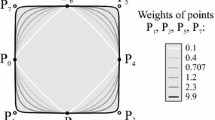Abstract
To create curves in computer graphics, we use, among others, B-splines since they make it possible to effectively produce curves in a continuous way using a small number of de Boor’s control points. The properties of these curves have also been used to define and create boundary geometry in boundary problems solving using parametric integral equations system (PIES). PIES was applied for resolution 2D boundary-value problems described by Laplace’s equation. In this PIES, boundary geometry is theoretically defined in its mathematical formalism, hence the numerical solution of the PIES requires no boundary discretization (such as in BEM) and is simply reduced to the approximation of boundary functions. To solve this PIES a pseudospectral method has been proposed and the results obtained were compared with both exact and numerical solutions.







Similar content being viewed by others
References
Zienkiewicz O (1977) The finite element methods. McGraw-Hill, London
Beer G, Watson JO (1992) Introduction to finite and boundary element methods for engineers. Wiley, New York
Beskos DE (1987) Boundary element methods in mechanics. North-Holand, Amsterdam
Brebbia CA, Telles JCF, Wrobel LC (1984) Boundary element techniques, theory and applications in engineering. Springer, Berlin Heidelberg New York
Camp CV, Gipson GS (1991) Overhauser elements in boundary element analysis. Math Comput Model 15(3–5):59–69
Johnston PR (1996) Second order overhauser elements for boundary element analysis. Math Comput Model 26:61–74
Johnston PR (1997) C 2-continuous elements for boundary element analysis. Int J Num Meth Eng 40:2087–2108
Liggett JA, Salmon JR (1981) Cubic spline boundary elements. Int J Num Meth Eng 17:543–556
Sen D (1995) A cubic-spline boundary integral method for two-dimensional free-surface flow problems. Int J Num Meth Eng 38:1809–1830
Cabral JJSP, Wrobel LC, Brebbia CA (1990) A BEM formulation using B-splines: I—uniform blending functions. Eng Anal With Bound Elem 7:136–444
Watson JO (1982) Hermitian cubic boundary elements for plane problems of fracture mechanics. Res Mech 4:23–42
Durodola JF, Fenner RT (1990) Hermitian cubic boundary elements for two-dimensional potential problems. Int J Num Meth Eng 30:1051–1062
Gray LJ, Soucie CS (1993) A Hermite interpolation algorithm for hypersingular boundary integrals. Int J Num Meth Eng 36: 2357–2367
Singh KM, Kalra MS (1995) Application of cubic hermitian algorithms to boundary element analysis of heat conduction. Int J Num Meth Eng 38:2639–2651
Zieniuk E (1998) Analytical modification of the boundary integral equations for the boundaries approximated by linear segments. Bull Soc Sci Lett Lódz, ser: recherches sur les Déformmations XXVI:71–82
Zieniuk E, Szczebiot R (1999) Modification of the boundary geometry in boundary value problems based on the new system of integral equations. In: Proceedings of the fifth workshop PTSK "Simulation in research and development” Warsaw, pp. 355–366
Mortenson M (1985) Geometric modelling. John Wiley and Sons, Chichester
Zieniuk E (2001) Potential problems with polygonal boundaries by a BEM with parametric linear functions. Eng Anal Bound Elem 25(3):185–190
Zieniuk E (2002) A new integral identity for potential polygonal domain problems described by parametric linear functions. Eng Anal Bound Elem 26(10):897–904
Faux I, Pratt MJ (1979) Computational geometry for design and manufacture. Wiley, New York
Rogers DF, Adams JA (1976) Mathematical elements for computer graphics. McGraw-Hill, New York
Zieniuk E (2003a) Hermite curves in the modification of integral equations for potential boundary-value problems. Eng Comput 20(2):112–128
Zieniuk E (2003b) Bézier curves in the modification of boundary integral equations (BIE) for potential boundary-values problems. Int J Solids Struct 40(9):2301–2320
Gottlieb D, Orszag SA (1977) Numerical analysis of spectral methods. SIAM, Philadelphia
Author information
Authors and Affiliations
Corresponding author
Rights and permissions
About this article
Cite this article
Zieniuk, E. Modelling and effective modification of smooth boundary geometry in boundary problems using B-spline curves. Engineering with Computers 23, 39–48 (2007). https://doi.org/10.1007/s00366-006-0040-z
Received:
Accepted:
Published:
Issue Date:
DOI: https://doi.org/10.1007/s00366-006-0040-z



